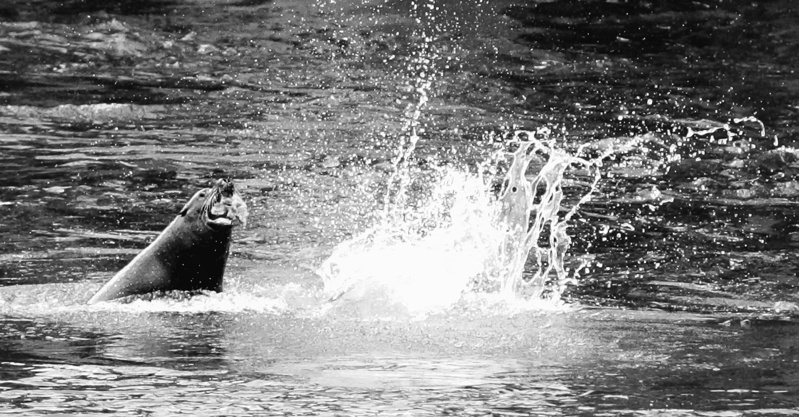Wildlife officials have tried everything to keep sea lions from eating endangered salmon, dropping bombs that explode under water and firing rubber bullets and bean bags from shotguns and boats. Now they are resorting to issuing death sentences to the most chronic offenders.
A California sea lion last week became the first salmon predator to be euthanized this year under a program that has been denounced by those who say there are far greater dangers to salmon – including the series of hydroelectric dams on the Columbia River.
This is the second year of the program, which is administered by wildlife officials in Oregon and Washington and the National Oceanic and Atmospheric Administration.
Last year, 11 sea lions were euthanized. Another four were transferred to zoos or aquariums.
The sea lions represent a massive headache each year as chinook salmon begin arriving at the Bonneville Dam east of Portland, Ore., congregating in large numbers as they return from the ocean. Sea lions have become keenly aware that the dam is a great spot to feast on salmon, easy pickings as they wait to go up the dam’s fish ladders.
“They learn. They come up here and know it’s a good place to eat, and sooner or later the salmon are going to arrive,” said Robert Stansell, a fisheries biologist with the U.S. Army Corps of Engineers.
Officials are tracking 63 additional sea lions listed as repeat offenders. They are identified by scars or by numbers that were branded on them by researchers.
“To get on that list, we have to have observed them as distinct individuals,” said Jessica Sall, spokeswoman for the Oregon office of the U.S. Fish and Wildlife Service. “They are not responding to hazing, and they’re eating chinook salmon.”
Sea lions have gobbled salmon forever. But their numbers have soared in recent years, as has the number of those cruising upriver to dine on salmon at Bonneville Dam. Frustrations peaked, especially among fishermen who have watched sea lions snatch salmon right out of their gill nets.
The Bonneville crowd of hefty mammals – they can reach more than 600 pounds and 8 feet in length – have become the enemy of commercial and sport fishermen, who are allowed to catch and keep hatchery-raised fish, and a concern for conservationists trying to restore migratory runs, since sea lions don’t distinguish between hatchery and wild fish.
Send questions/comments to the editors.



Success. Please wait for the page to reload. If the page does not reload within 5 seconds, please refresh the page.
Enter your email and password to access comments.
Hi, to comment on stories you must . This profile is in addition to your subscription and website login.
Already have a commenting profile? .
Invalid username/password.
Please check your email to confirm and complete your registration.
Only subscribers are eligible to post comments. Please subscribe or login first for digital access. Here’s why.
Use the form below to reset your password. When you've submitted your account email, we will send an email with a reset code.